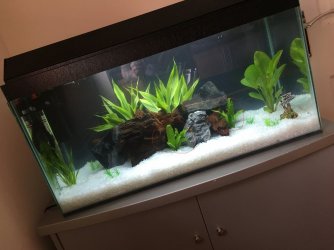I concur with essjay in post #2. As for the houseplant, it is probably Dracaena variegata which is a yellow-striped variety, similar to the white-strip D. sanderiana. It is true that this terrestrial plant can live submersed for a few months, but it may suddenly begin to melt/decompose, and can be quite a mess biologically as well as visually, so be careful. If this were me, I would find a true aquatic to replace it before that happens.
As for the sword which is indeed an Echinodorus, no doubt there, but as to the species...E. cordifolius (often commonly called the Radican Sword, more below on why)) is a possibility, maybe more a probability. But this genus is taxonomically very confused [also more below]. I cannot tell just from the photo, but as you are there to examine the plant, if the petiole (the name for the stem of the leaf) is triangular, it is more likely E. cordifolius. The blades (leaves) are oval to ovate, usually acute (= pointed tip), with five to nine longitudal veins (I can see five here on the older, outer leaves quite clearly) and are light to medium green, sometimes displaying reddish spots; new leaves regularly appear from the centre of the crown (as is occurring here) and the initially-brownish blades unfold and become light green as they grow somewhat slowly towards the surface.
The new leaves are already showing different size characteristics, which is normal. All species are perennial or annual aquatic or marsh plants found in boggy flood areas or along the banks of stagnant or slow-flowing waters. Except for the very few species that are permanently submersed, Echinodorus plants spend half the year emersed (when they flower) and the remainder submersed during the flood season. Leaves arise in a rosette and can be very variable not only between emersed and submersed forms but also when cultivated under different conditions. Correct identification often requires study of the flower. Inflorescences (flower stalks) are formed in all species; when grown permanently submersed in the aquarium most species will not flower but plantlets (daughter plants) will develop from the nodes on the inflorescence. Use a quality substrate fertilizer tab, such as Flourish Tabs, one near the roots of this plant, replaced every three months, and it will thrive and produce adventitious plants from the inflorescences that will appear when the plant is settled.
Now for the taxonomic issues, for those interested, the "Radicans Sword" explanation. Several authors have considered this plant to be E. ovalis or E. fluitans; Haynes & Holm-Nielsen (1994) proposed that the three were a single polymorphic species having the subspecies E. cordifolius cordifolius and E. c. fluitans. Lehtonen's (2008) phylogenetic analysis established E. fluitans as conspecific with E. cordifolius, and E. ovalis is not a distinct species but is within the E. cordifolius-ovalis clade. Sagittaria radicans had been described as a new species by Nuttal (1835), but subsequently determined to be the same species as Aisma cordifolia which had been previously described as a distinct species by Carl Linnaeus in 1753. Engelmann (1848) had named this sword plant E. radicans, which was based on the type for Sagittaria radicans described by Nuttall (1835). Subsequently, it was reclassified as Echinodorus cordifolius by the German botanist August Grisebach in 1857; the species epithet refers to the cordate leaves. Under the rules of the International Code of Botanical Nomenclature, the species epithet ("cordifolius" here) that is first assigned to a distinct species must prevail, even though the genus may change. "Radicans" was somehow taken up as a common name, though it is invalid scientifically, being synonymous with E. cordifolius.
If the above has not completely confused you...In his earlier work on the genus, Rataj (1975) listed 47 species in Echinodorus. A major revision by the botanists R.R. Haynes and L.B. Holm-Nielsen (1994) listed 26 species. In his 2004 revision, Rataj increased the number of species to 62. More recent work by Samuli Lehtonen—incorporating phylogenetic (DNA) analysis—proposed 28 valid species (Lehtonen, 2008). A couple more have since been discovered, and as of 2013, The Plant List and the World Checklist of Selected Plant Families (maintained by Kew) have 30 distinct species listed for Echinodorus. Echinodorus cordifolius is as I've noted above a valid species; four other former "species" are now established as being the same, so their names are invalid as they are synonymous: Echinodorus fluitans, Echinodorus ovalis, Echinodorus radicans, and Echinodorus schlueteri.


